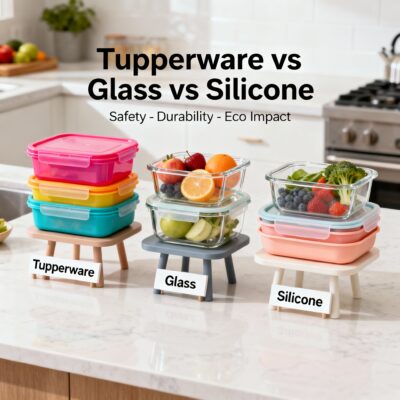Not sure which food storage container is best for your home? You’re not alone! Today’s shelves are packed with lots of options—each with its pros and cons. Whether you’re packing lunches, freezing leftovers, or storing snacks, it’s important to pick a container that’s safe, durable, and eco-friendly. Let’s break down Tupperware, glass, and silicone to see how they stack up.
Why Container Material Matters
We all want to keep our food fresh and our families healthy. The material you use can make a difference! Some containers are better for the planet, while others win on convenience. Understanding the basics will help you choose wisely.
Safety Comparison
-
Tupperware (Plastic): Modern Tupperware is BPA-free, so it’s generally safe for food. However, avoid exposing plastic to high heat or microwaving for long periods.
-
Glass: Non-porous and free from chemicals, glass won’t leach into food—no matter what’s inside. It’s safe for both microwave and oven use (without a plastic lid).
-
Silicone: Food-grade silicone is heat resistant and non-toxic. Good silicone products are safe for microwaves, ovens, and even boiling water.
Durability and Convenience
-
Tupperware: Lightweight and nearly unbreakable, making it perfect for on-the-go lunches and outdoor picnics.
-
Glass: Heavy and can break if dropped, but won’t stain or hold odors. Great for both storage and serving.
-
Silicone: Flexible and tough—hard to break, easy to squeeze into tight spaces, and often collapsible for storage.
Eco Impact
-
Tupperware: Reusable but made from petroleum-based plastic. Long life means less waste than single-use containers, but not as green as glass or silicone.
-
Glass: Made from natural materials and fully recyclable. It lasts for years and won’t absorb food stains or smells.
-
Silicone: Made from sand (silica), it’s endlessly reusable and more eco-friendly than most plastics. Not always recyclable everywhere, but lasts for years if cared for.
Buyer’s Quick-Compare Table
| Feature | Tupperware (Plastic) | Glass | Silicone |
|---|---|---|---|
| Safety | BPA-free, avoid high heat | No leaching, safe for oven | Heat-resistant, non-toxic |
| Durability | Lightweight, shatterproof | Heavy, breakable | Flexible, unbreakable |
| Stain/Odor Proof | May stain, absorb odor | Resists stains, no odor | Resists most stains/odors |
| Eco Impact | Reusable, not easily recycled | Recyclable, long-lasting | Eco-friendly, reusable, partially recyclable |
| Cost | Most affordable | Moderate | Slightly higher cost |
| Best For | Kids, travel, light storage | Home, freezer, serving | Freezer, oven, lunchboxes |
Bottom Line
No single material is perfect for every home. Tupperware wins for lightness and everyday use. Glass shines for long-term storage and food safety. Silicone is a flexible, eco-conscious choice for busy kitchens. Think about how you’ll use your containers most, and choose what suits your lifestyle!



